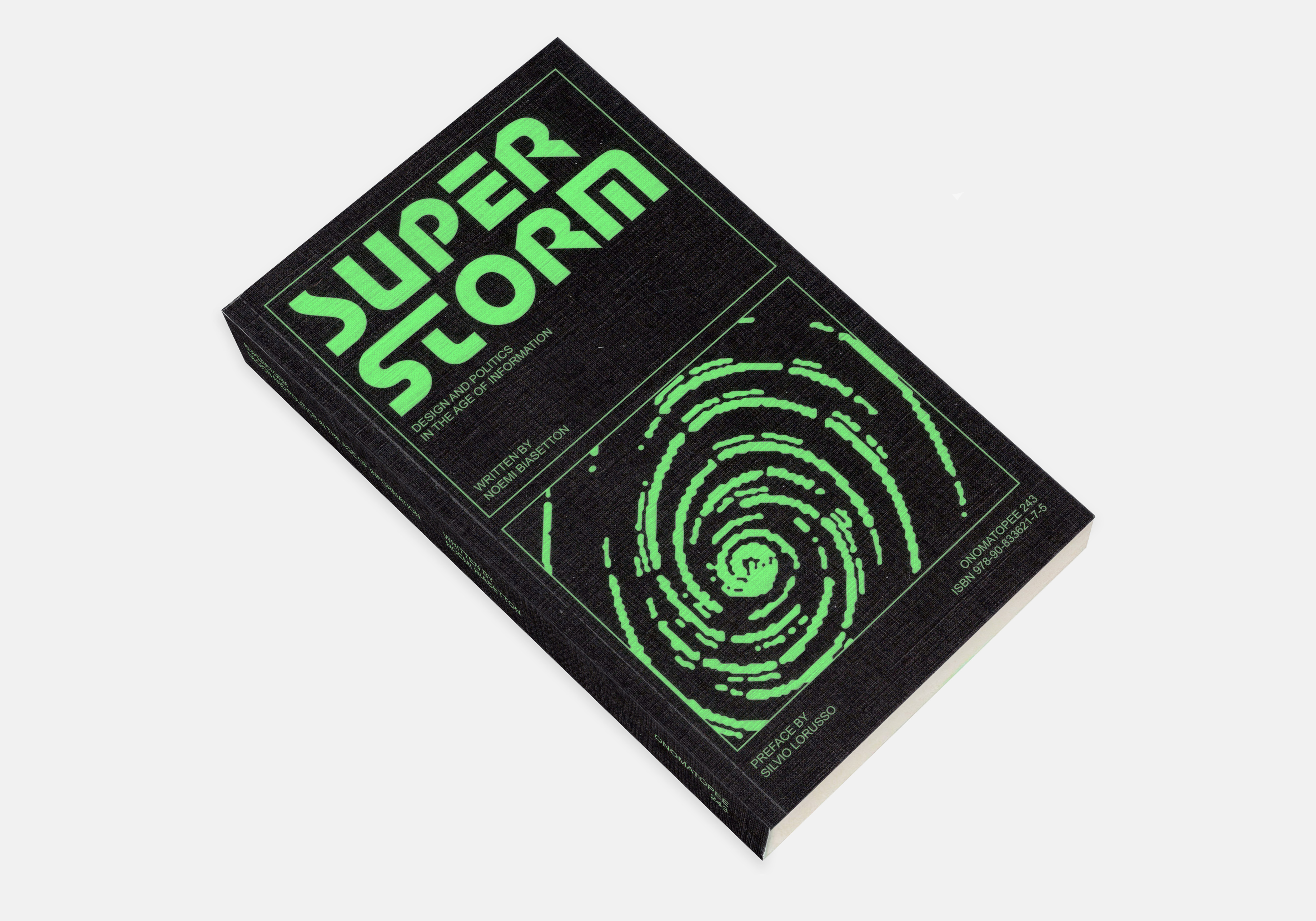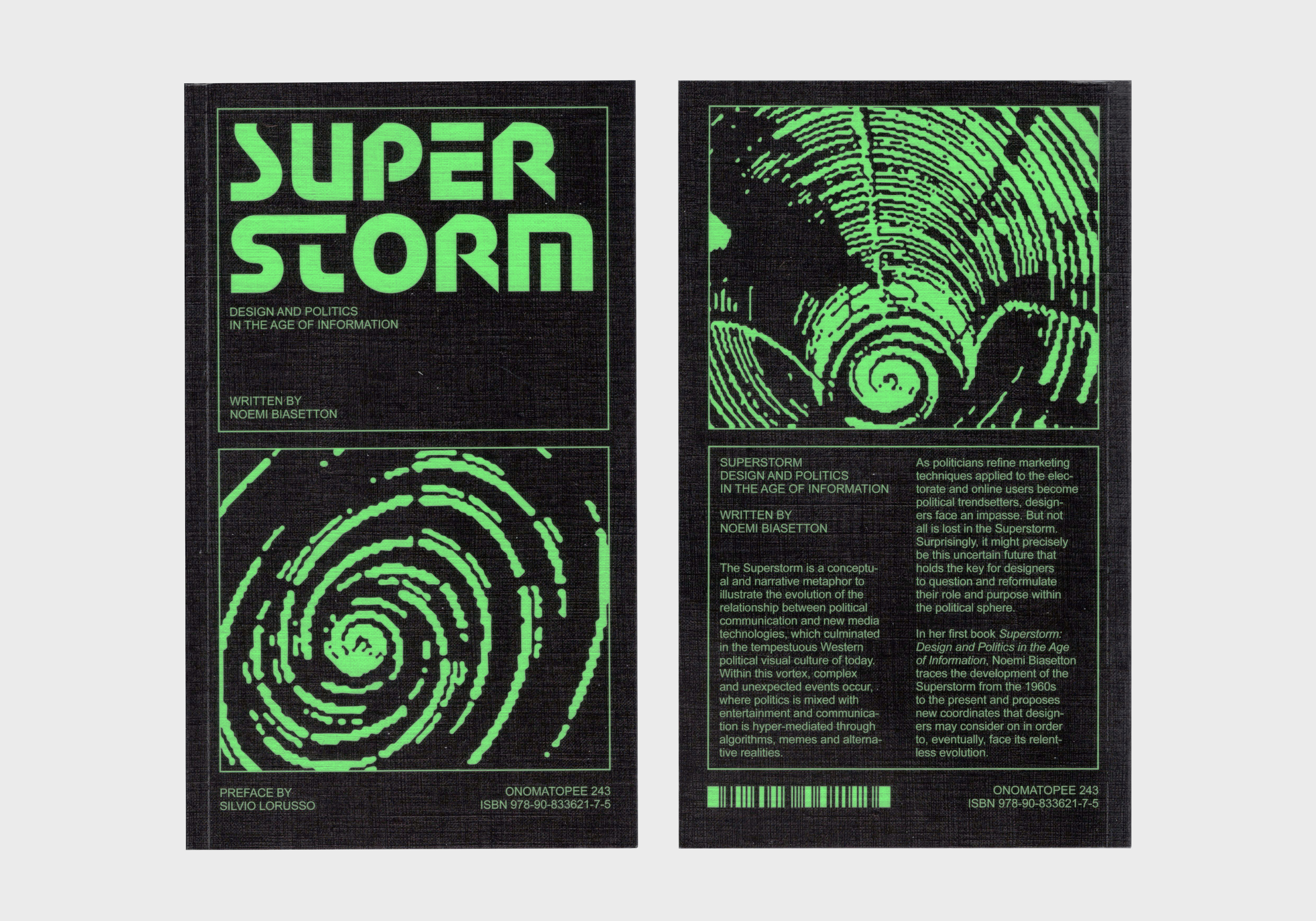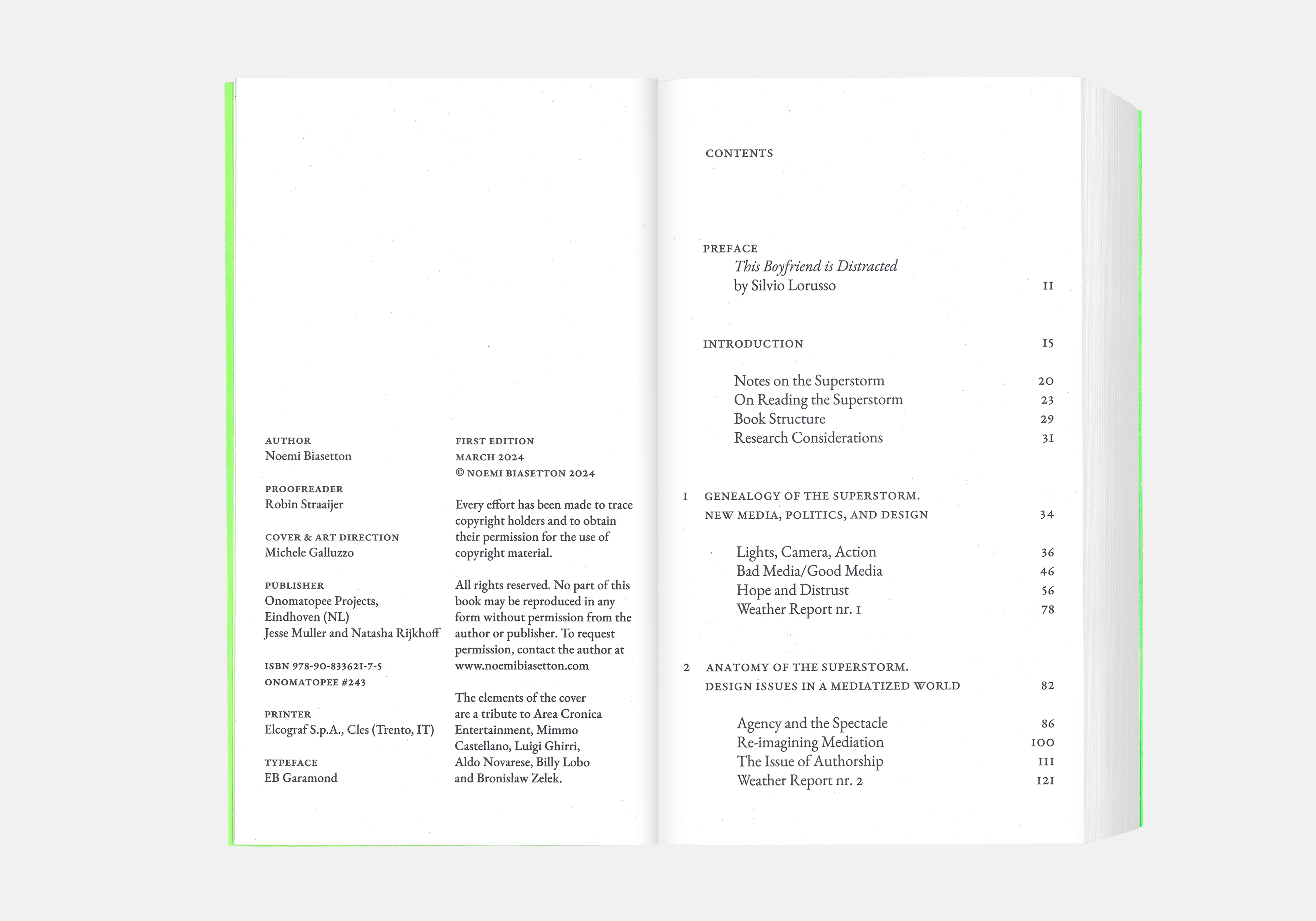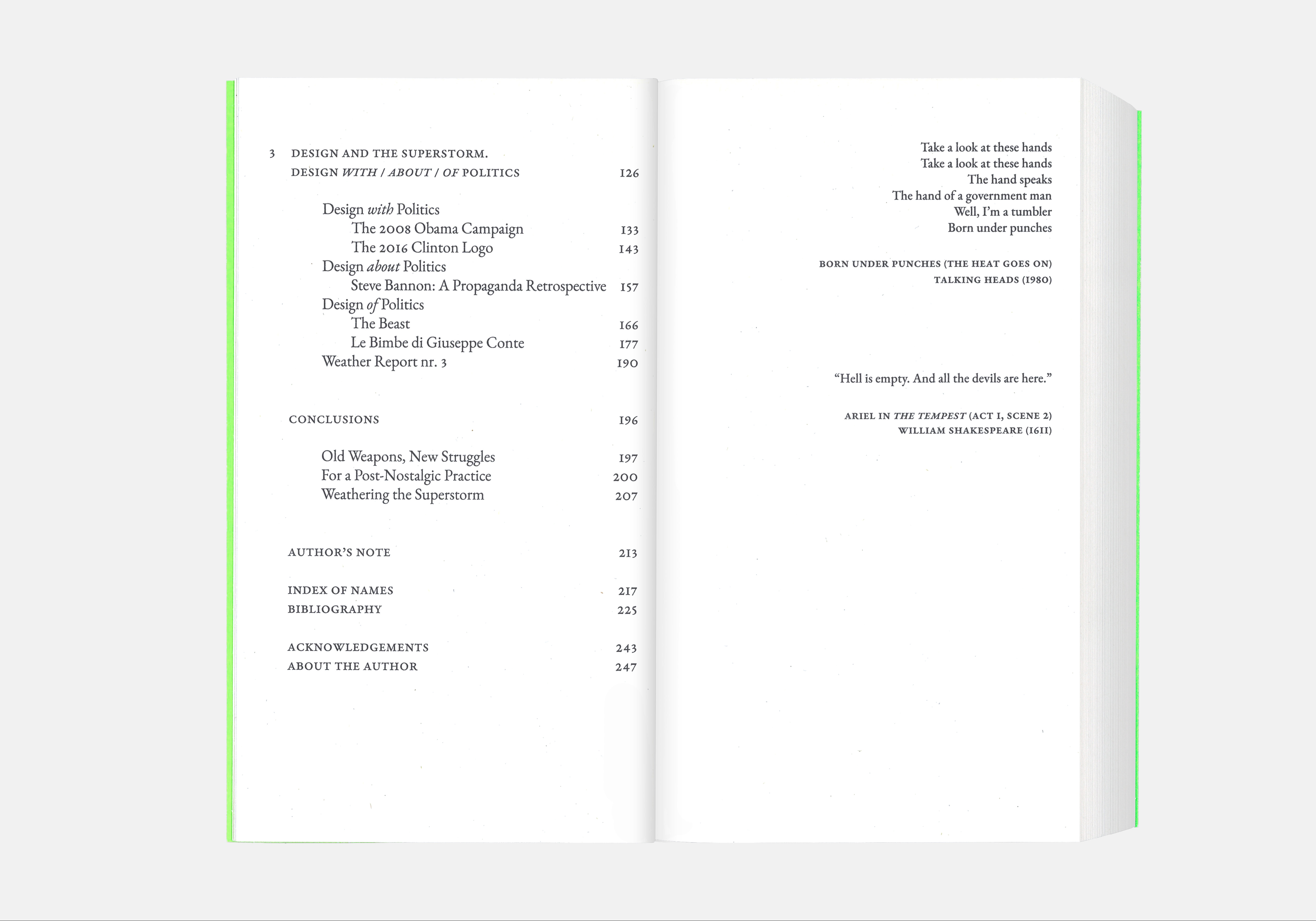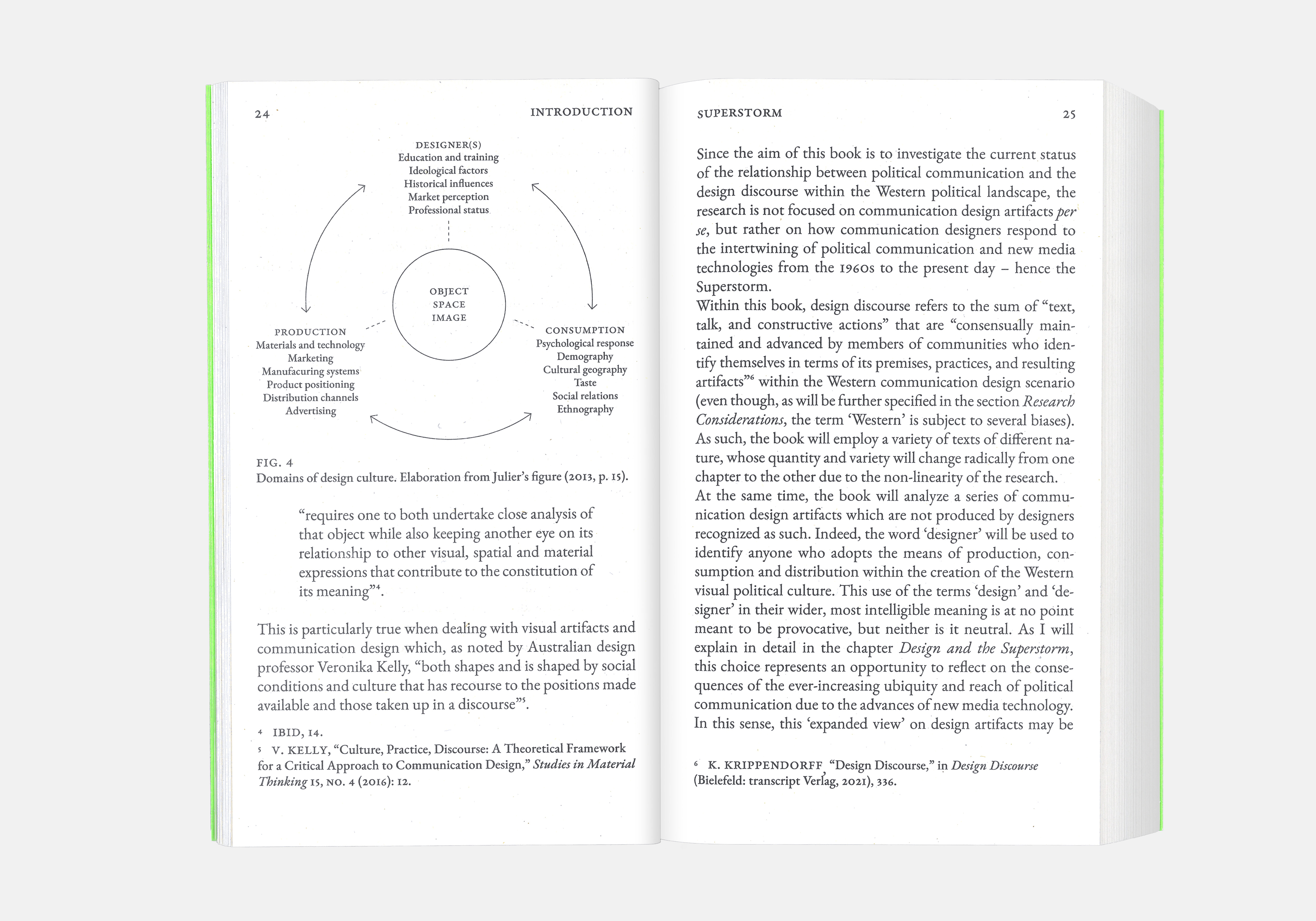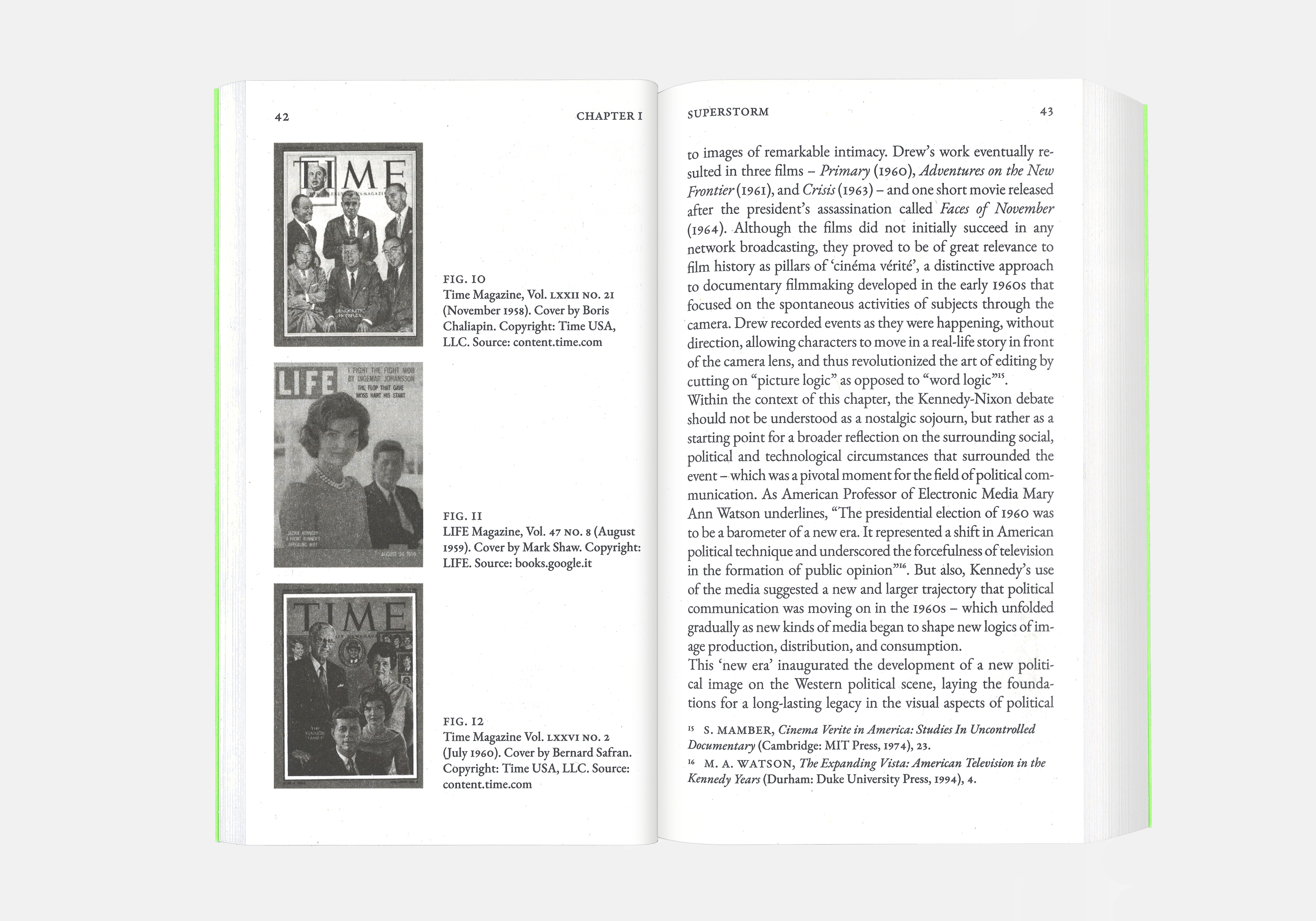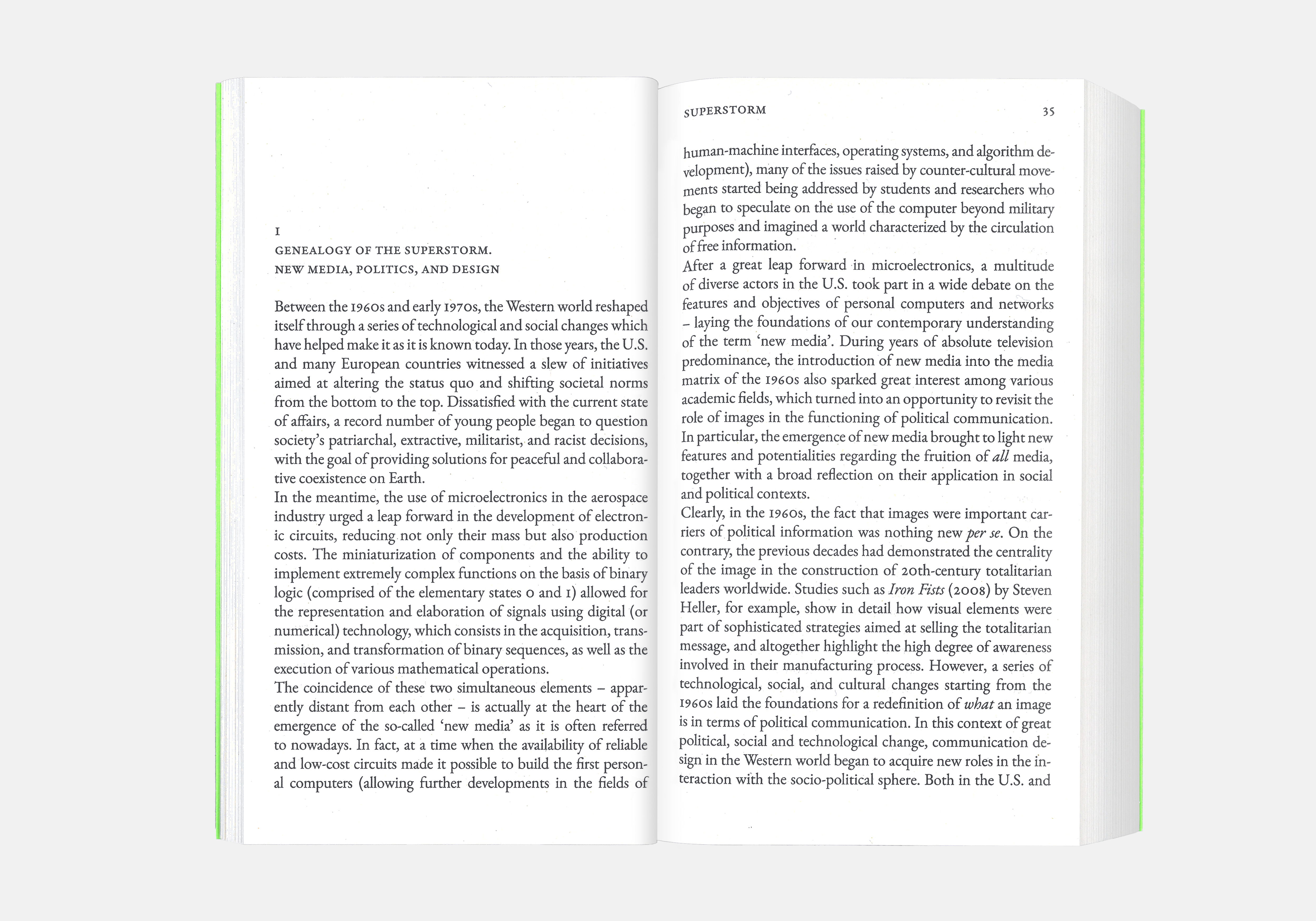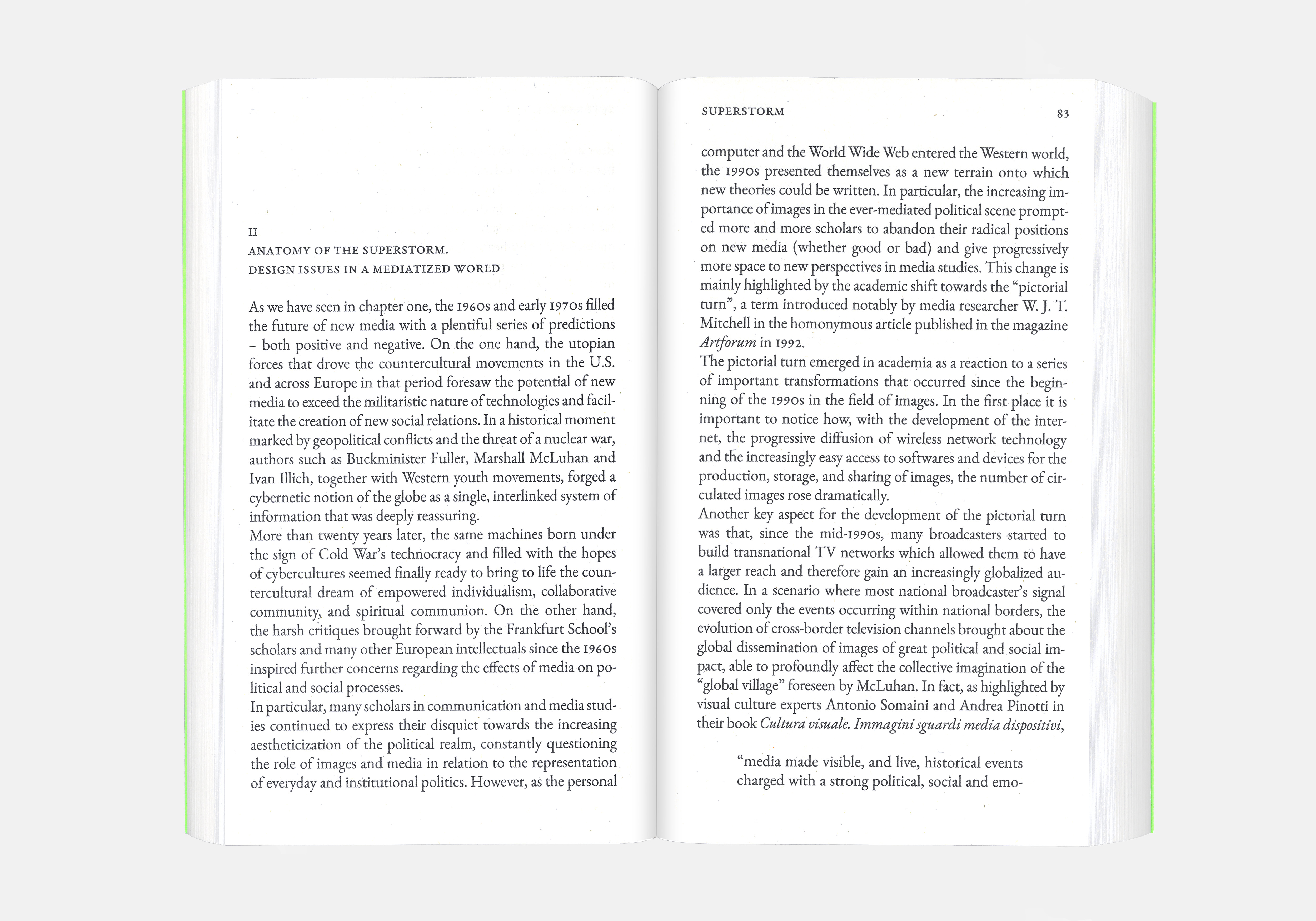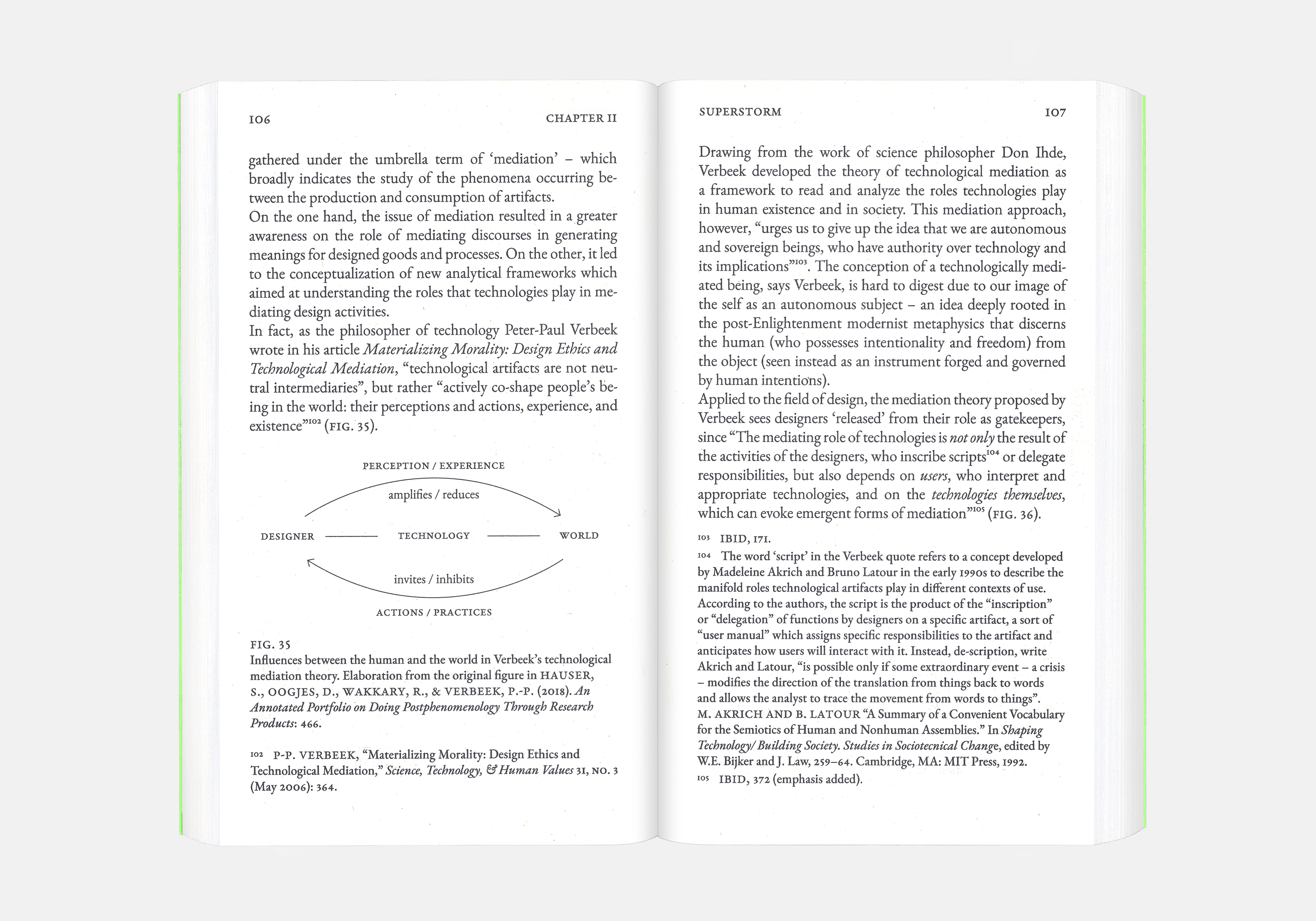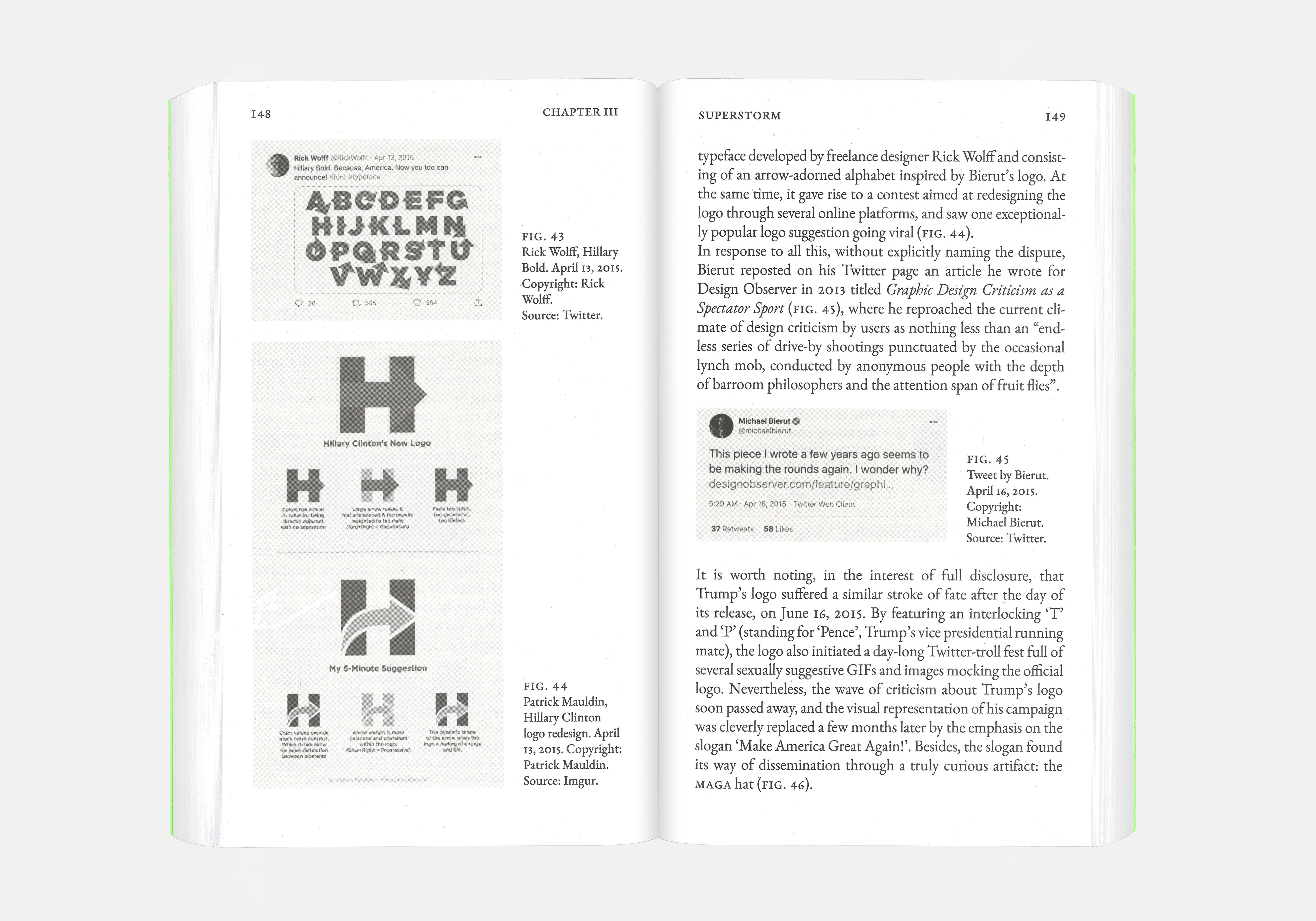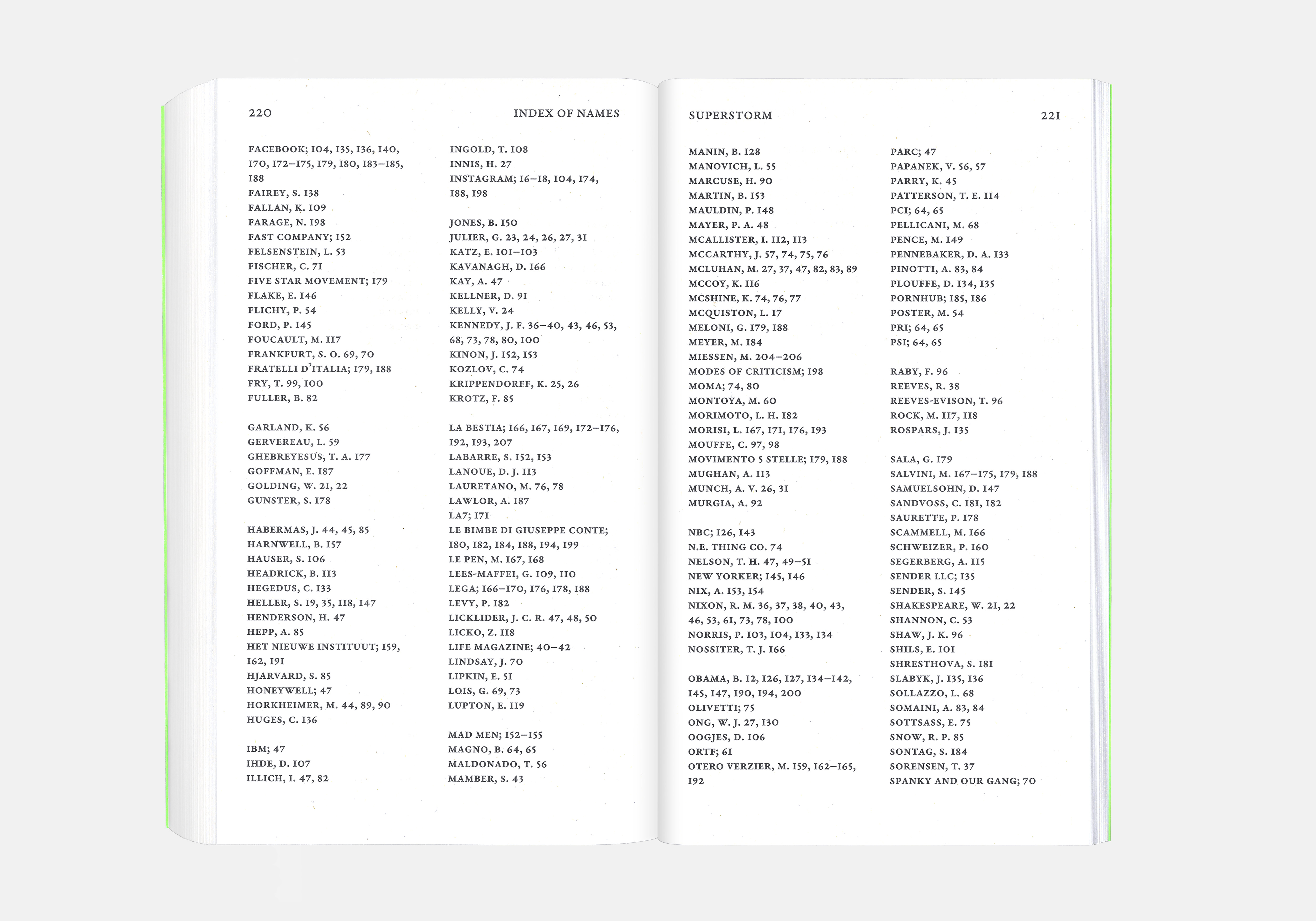Textual
SUPERSTORM. Design and Politics in the Age of Information
Onomatopee
2024
Kind:
Abstract:
The Superstorm is a conceptual and narrative metaphor to illustrate the evolution of the relationship between political communication and new media technologies, which culminated in the tempestuous Western political visual culture of today. Within this vortex, complex and unexpected events occur, where politics is mixed with entertainment and communication is hyper-mediated through algorithms, memes and alternative realities.
As politicians refine marketing techniques applied to the electorate and online users become political trendsetters, designers face an impasse. But not all is lost in the Superstorm. Surprisingly, it might precisely be this uncertain future that holds the key for designers to question and reformulate their role and purpose within the political sphere.
In her first book Superstorm: Design and Politics in the Age of Information, Noemi Biasetton traces the development of the Superstorm from the 1960s to the present and proposes new coordinates that designers may consider on in order to, eventually, face its relentless evolution.
Author: Noemi Biasetton
Publisher: Onomatopee Project (Eindhoven, NL)
Cover and Art direction: Michele Galluzzo
Preface: Silvio Lorusso
Proofreader: Robin Straaijer
Onomatopee Project manager: Jesse Muller, Natasha Rijkhoff
Resources:
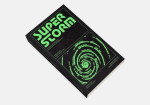
superstorm_01.jpg |
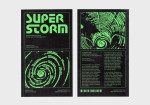
superstorm_02.jpg |
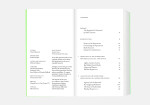
superstorm_03.jpg |
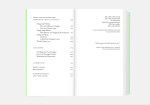
superstorm_04.jpg |

superstorm_05.jpg |
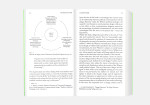
superstorm_06.jpg |
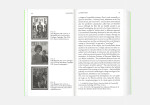
superstorm_07.jpg |
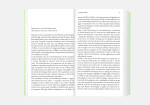
superstorm_08.jpg |
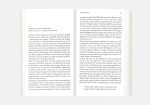
superstorm_09.jpg |
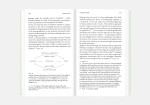
superstorm_10.jpg |
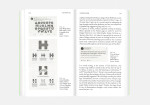
superstorm_11.jpg |

superstorm_12.jpg |
SUPERSTORM / Lecture
Circolo del Design
2024
Kind:
Other
Abstract:
Presentazione del libro SUPERSTORM. Design and Politics in the Age of Information, edito da Onomatopee presso il Circolo del Design di Torino.
Nel volume si ripercorre lo sviluppo della Supertempesta, una metafora concettuale e narrativa per illustrare l'evoluzione del rapporto tra la comunicazione politica e i nuovi media, dagli anni Sessanta a oggi, culminata nell'attuale tempestosa cultura visiva politica occidentale.
All’interno di questo vortice accadono eventi complessi e inaspettati, dove la politica si mescola all’intrattenimento e la comunicazione è ipermediatizzata attraverso algoritmi, meme e realtà alternative.
Mentre i politici affinano le tecniche di marketing applicate all’elettorato e gli utenti online diventano trend-setter politici, i designer si trovano ad affrontare un vicolo cieco. Ma non tutto è perduto nella Supertempesta. Sorprendentemente, potrebbe essere proprio questo futuro incerto a fornire ai designer la chiave per mettere in discussione e riformulare il loro ruolo e scopo all’interno della sfera politica.
Resources:

superstormcdd_01.jpg |

superstormcdd_02.png |

superstormcdd_03.jpg |

superstormcdd_04.jpg |

superstormcdd_05.png |

superstormcdd_06.jpg |
Bookcloud — Third Edition
b-r-u-n-o
2024
Kind:
Spatial, Textual
Abstract:
In the concentric and enveloping space of the infosphere, it is increasingly difficult to understand the role that images play in our daily lives. From those of black holes produced by NASA to the bombing of Gaza, the figures that appear on our screens seem at once distant and very close, 'human' and machinic, sometimes full and sometimes devoid of agentivity.
At a time of profound discussion with respect to the social and political role of those involved in visual communication, the third edition of Bookcloud focuses on the relationship between information and visualization, starting with three texts dealing with visual studies, design criticism, and epistemology.
Ep. 10 Marco Ferrari with Operational Images. From the Visual to the Invisual by Jussi Parikka (University of Minnesota Press, 2023);
Ep. 11 Benedetta Crippa with Why Graphic Culture Matters by Rick Poynor (Occasional Papers, 2023);
Ep. 12 Irene Stracuzzi with Objectivity by Lorraine Daston and Peter Galison (Zone Books, 2007);
Project by: b-r-u-n-o
Curated by: Noemi Biasetton
Resources:

bookcloud_10.jpg |

bookcloud_11.jpg |

bookcloud_12.jpg |

bookcloud_13.jpg |

bookcloud_14.jpg |
MAUDIT | Immagini e Immaginari nelle Alpi
Free University of Bozen-Bolzano
2024
Kind:
Spatial, Visual
Abstract:
MAUDIT — Immagini e Immaginari nelle Alpi è un simposio che esplora le narrazioni visuali legate al territorio alpino attraverso la presenza di ricercatori e ricercatrici, attivisti, progettiste e associazioni attive sul territorio. La giornata è divisa in tre momenti di discussione che ripercorrono le modalità, gli apparati e i canoni che, fin dal Settecento, sono stati impiegati per raccontare le Alpi e il suo paesaggio umano e non-umano. L’obiettivo di MAUDIT è di tracciare una genealogia collettiva dell’immagine alpina attraverso un momento dialogico di apprendimento orizzontale e partecipato.
T01 — MITOLOGIE dalle 11 alle 12.30
Elisabetta Dall’Ò, Antropologa (UniTo)
Eleonora Mastropietro, Geografa (UniMi)
Daniele Ietri, Geografo (unibz)
Elisabeth Tauber, Antropologa (unibz)
T02 — SPETTACOLARIZZAZIONI dalle 14 alle 15.30
Flavio Pintarelli, Scrittore
Beatrice Citterio, Protect Our Winters
Peter Righi, Alpenverein Südtirol
Federica Viganò, Sociologa (unibz)
T03 — FABULAZIONI dalle 15:30 alle 17
Filippo Andreatta, Office for a Human Theatre
Lisa Mazza, BAU
Bianca Elzenbaumer, La Foresta
Ingrid Kofler, Sociologa (unibz)
Comitato scientifico: Letizia Bollini, Serena Volo, Noemi Biasetton
Comitato organizzativo: Letizia Bollini, Noemi Biasetton, Beatrice Citterio
Grafica evento: Noemi Biasetton
Data: 5 Aprile 2024, h10—18
Luogo: aula C4.06, unibz
Resources:

maudit_programma.pdf |

maudit_poster.jpg |

maudit_simposio-01.jpg |

maudit_simposio-02.jpg |

maudit_simposio-03.jpg |

maudit_simposio-04.jpg |
Where the Wild Things Are: Un'introduzione al selvatico queer
Casa Punto Croce
2024
Kind:
Spatial
External link:
Abstract:
Where the Wild Things Are: Un'introduzione al selvatico queer è una breve lettura dell'albo illustrato di Maurice Sendak intermezzato da riflessioni teoriche tratte da Wild Things di Jack Halberstam. La lettura è avvenuta durante ORMONI | notizie da sotto le canottiere, il primo evento di NewStellar in alleanza con Casa.X
Data: 13 gennaio 2024
Ospiti: Noemi Biasetton, Elio Rosalba Bonaccini, collettivo Scafandra, Niccolò Pagni, Anarkologorroika, Camilla Dalmazio, l3 bibliomanti di .x
Organizzato da: NewStellar (Valentina Rizzi, Teresa Masini, Lucia Di Pietro)
Luogo: Casa Punto Croce (VE)
Resources:

ormoni_01.png |

ormoni_02.jpg |

ormoni_03.jpg |
Bookcloud — Second Edition
b-r-u-n-o
2023
Kind:
Textual, Spatial
Abstract:
The second edition of Bookcloud (available between July and October 2023) focuses on the relationship between utopia and ecology. In this context, the term 'ecology' is to be understood in its broadest sense and in its oldest etymology, that is, from the Greek oikos, 'environment,' and logos, 'study': study of the environment. The relationship between design and ecology in a broad sense underlies every choice that designers make, and in recent years it has been progressively discussed and analyzed by a whole strand of literature concerned with the non-exclusivity of human beings within the environments in which they operate – from the non-human to the digital. In this context, utopia and dystopia are two systems of vision that, due to their imaginative and speculative power, allow for uncomfortable questions to be posed towards the present and the future, trying to predict how humans will interact with a given environment based on the given present.
- Ep. 6 Fosbury Architecture with Il mondo nuovo. Ritorno al mondo nuovo di Aldous Huxley by Aldous Huxley (Mondadori 1989);
- Ep. 7 Davide Tommaso Ferrando with Interregno: Iconografie del XXI secolo by Mattia Salvia (NERO, 2022);
- Ep. 8 Institute for Postnatural Studies with Symbiotic Planet. A New Look at Evolution by Lynn Margulis (Basic Books, 1999);
- Ep. 9 Raimonda Riccini with La speranza progettuale. Ambiente e società by Tomás Maldonado (Einaudi, 1971);
Project by: b-r-u-n-o
Curated by: Noemi Biasetton
Resources:

bookcloud_05.jpg |

bookcloud_06.jpg |

bookcloud_07.jpg |

bookcloud_08.jpg |

bookcloud_09.jpg |
Bookcloud: Notes on an Experimental Project for the Future of Publishing
Valiz
2023
Kind:
Textual
Abstract:
The article brings to light a series of reflections that emerged following the production of the first edition of Bookcloud, a project that explores the relationship between literature and design through a series of conversations among practitioners from the fields of architecture, design, and arts starting from a book of their choice. In particular, the text suggests how the project has been a collaborative dialectical exercise between several parties: that of the independent publishing world, which performs a fundamental service in fostering communities; of researchers, who push the boundaries of knowledge in the field of design; and finally of the objects that enable all of the above to work: books.
Authors: Noemi Biasetton, b-r-u-n-o (Andrea Codolo & Giacomo Covacich)
Published in: Future Book(s). Sharing ideas on books and (art) publishing (Valiz), pp. 128 – 130
Resources:

bookcloudvaliz_01.jpg |

bookcloudvaliz_02.jpg |

bookcloudvaliz_03.jpg |
ZINE ZINE ZINE
Weigh Station
2023
Kind:
Spatial
Abstract:
Zines: From Science Fiction to Subcultures is a two hours lecture on the evolution of (fan)zines throughout the 20th century. The lecture explores the role occupied by zines in creating and nurturing marginalised social groups, fostering their diffusion and cultivating the rise of sub-alternative cultures facing a diverse spectrum of societal challenges.
Speaker: Noemi Biasetton
Host: Weigh Station (Bozen-Bolzano, IT)
Date: June 21, 2023
Resources:

zinezinezine_weighstation.jpg |
Bookcloud – First Edition
b-r-u-n-o
2023
Kind:
Textual, Spatial
Abstract:
Bookcloud is a project that explores the relationship between the contemporary design scenario and literature through a series of conversation with researchers and practitioners from the fields of architecture, design, and arts starting from a book of their choice. The conversations are printed and distributed for free at bruno’s bookshop. The first edition of Bookcloud (distributed between January and February 2023) focuses on seven texts that explore the relationship between politics and design through the topics of participation and architecture, capitalism and graphic design, ecology and anthropology, anarchy and science fiction, wildness and queerness – investigating their current possibilities, past experiences and futurable scenarios.
- Ep. 1 Tommaso Guariento with The Nightmare of Participation (Crossbench Praxis as a Mode of Criticality) by Markus Miessen (Sternberg Press, 2011);
- Ep. 2 Silvio Lorusso with CAPS LOCK. How Capitalism Took Hold of Graphic Design, and How to Escape from It by Ruben Pater (Valiz, 2021);
- Ep. 3 Martina Muzi with The Mushroom at the End of the World by Anna Lowenhaupt Tsing (Princeton University press, 2015);
- Ep. 4 Ruben Pater with Two Cheers for Anarchism by James C. Scott (Princeton University Press, 2012) and The Dispossessed by Ursula K. Le Guin (Harper & Row, 1974);
- Ep. 5 Annalisa Sacchi with Wild Things: The Disorder of Desire by Jack Halberstam (Duke University Press, 2020) and C’era una volta una bambina by Zoboli and Concejo (Topipittori, 2015)
Project by: b-r-u-n-o
Curated by: Noemi Biasetton
Resources:

bookcloud_01.jpg |

bookcloud_02.jpg |

bookcloud_03.jpg |

bookcloud_04.jpg |
Crisis x Critique
DAE / SaloneSatellite
2023
Kind:
Other
Abstract:
Crisis x Critique is a conversation held at Elevator Radio, organised by Design Academy Eindhoven during Salone del Mobile Milano 2023 .
Guests: Max Fraser, Oli Stratford, Ilse Meulendijks, Noemi Biasetton
Moderator: Anna Winston
Elevator Radio members: Guanyan Wu, Noa de Sousa Costa
Resources:

cxc_01.jpg |

cxc_02.jpg |

cxc_03.jpg |

cxc_04.jpg |
Matters of Lives | Notes and Records on the Pluriverse
ADI Design Museum
2023
Kind:
Visual
Abstract:
The new millennium has been marked by a strong interest towards the dismantlement of the alleged exclusivity of anthropocentric knowledge. Whether in the form of precarious coexistence, cooperation, co-evolution, or conflict, humankind rediscovers itself as one of the nodes of an intricate mesh which spans from the microscopic to the atmospheric scale, giving birth to a new conception of the world: the Pluriverse. But how does this new vision of global ecology connect to design practices? And how do we deal with the forms and aesthetics created by the Pluriverse’s relationships and meshes?
Matters of Lives | Notes and Records on the Pluriverse is a project that stems precisely from these issues and questions. The first part of the book contains six short essays written by the editors together with external authors involved in the research phase of the project. The same section includes four conversations with Italian researchers working on the edge of the Pluriverse – from microbiology to environmental law and cooking – to gain further insights. The second part of the book is a record of what took place during a series of three encounters held in September 2022 at the margins of the Venetian lagoon, which featured objects, people and other living things presented through a variety of heterogeneous outputs: installations, workshops, talks, panel discussions, performances and more.
Edited by: Noemi Biasetton, Costanza Sartoris, Matteo Vianello
Contributions by: Tommaso Guariento, Federica Timeto, Monica Nadegger, Isabella Pinto, Silvia Biasetton, Andreas Philippopoulos- Mihalopoulos, Roberto D’Alba, Lucilla Barchetta, Giulia Barison, Guilherme Pratti, Clelia Cadamuro, HAB (Melissa Grant, Heidi Pietarinen, Noora Sandgren, Anne Yoncha), Eléonore Geissler, boglárka lutz, Tocia!, Laura Hyunjhee Kim, Kevin Sweet, Faid Ahmad, Georgia Jamieson, Ilya Martynov, Katie Pelikan Baselj, Elisa Piazzi, Aleksandra Przybysz
Exhibited at: ADI Design Museum | ITALY: A New Collective Landscape
Curated by: Angela Rui with Elisabetta Donati de Conti and Matilde Losi
Resources:

mattersoflives_01.jpg |

mattersoflives_02.jpg |

mattersoflives_03.jpg |

mattersoflives_04.jpg |

mattersoflives_05.jpg |

mattersoflives_06.jpg |
For F☆ck’s Sake
Springer
2023
Kind:
Textual
Abstract:
In the last 20 years, the industry of sex toys has grown exponentially within the Western online market, giving life to new forms of communication regarding topics such as sex and sexuality. However, if on one hand the online sale of sex toys and its related communication allow (once again) the spread of political narratives, on the other they seem to reinforce an individual and self-determining conception of sex and sexuality which preclude its broader understanding within societal norms and omit forms of collective and shared practices related to such topics.
To understand the consequences of this paradox, the paper will focus on sex toys as carriers of political narratives related to sex and sexuality, reflecting especially on the role of that online communication might have on their diffusion. To achieve this, the paper takes into consideration the visual communication of MySecretCase as a case study and analyze it through the visual methodology proposed by Gillian Rose. Through the analysis of the communication design strategies adopted by MySecretCase, we aim at interrogating whether – if confined in the virtual space – sex toys can still be considered as carriers of political and collective values, reflecting on the role of communication design in shaping the symbolic narrative around these objects.
Co-author: Silvia Biasetton
Published in: Series in Design and Innovation, Springer
Resources:

forfckssake_01.jpg |
Nuovi Media, Politica e Design
Università IUAV di Venezia
2022
Kind:
Spatial
External link:
Abstract:
Durante il suo intervento 'Nuovi Media, Politica e Design', Noemi Biasetton offrirà una breve panoramica storica rispetto all’evoluzione del rapporto tra design della comunicazione, comunicazione politica e nuovi media durante gli anni ’60 e ’70. In seguito, si rifletterà collettivamente sull’eredità di questo periodo storico rispetto alle pratiche progettuali nello scenario politico contemporaneo.
Al perpetuo Crepuscolo | Società dell’Informazione tra propaganda e meme consiste in due giornate seminariali per discutere gli effetti che i nuovi media e le loro logiche hanno avuto sul mondo della politica e, più in generale, il rapporto tra estetica e politica nella società dell’informazione.
Guest speakers: Noemi Biasetton, Alessandro Lolli, Alex Orlowski, Mattia Salvia
Curato da by: Stefania D’Eri, Serena De Mola, Alessandro Durighello
Finanziato da: Senato degli studenti dell’Università Iuav di Venezia
Data: 24 ottobre 2022
Resources:

apc_programma.pdf |

apc_poster.jpg |
Matters of Lives | Encounters on the Edge of the Pluriverse
Meta Forte
2022
Kind:
Spatial
Abstract:
While the future of our species is in increasingly put into doubt, humankind is slowly rediscovering itself as one of the nodes of an intricate mesh, which links the epidermis of our skin to the soil’s geology. This mesh, which spans from the microscopic to the atmospheric scale and harmonizes traditional wisdom with contemporary research, gave birth to a new model of the globe in continuous expansion – the Pluriverse. But how does this new vision of the global ecology connect to design practices? And how do we deal with the forms and aesthetics created by the Pluriverse’s relationships and meshes?
Matters of Lives | Encounters on the Edge of the Pluriverse consists of a series of gatherings which stem precisely from these issues and questions, and represents a shared effort to bring these topics together and stimulate discussion through embodied practices and shared knowledge. Born from an open call in late 2021, the project materialized during three weekends in September 2022, offering a series of collective encounters – in the form of talks, performances and workshops – where the invited researchers, designers, and artists discussed and engaged with the public through their work in the spaces of Meta Forte (Cavallino Treporti, Venice).
Curators: Noemi Biasetton, Costanza Sartoris, Matteo Vianello
Projects by: Clelia Cadamuro, Tocia!, Laura Hyunjhee Kim and Kevin Sweet, Aleksandra Przybysz, Katie Pelikan Baselj, Eléonore Geissler, Faid Ahmad and Georgia Jamieson, HAB, Elisa Piazzi, boglárka lutz and Ilya Martynov
Exhibited at: Meta Forte
Resources:

encounters_00.jpg |

encounters_01.jpg |

encounters_02.jpg |

encounters_03.jpg |

encounters_04.jpg |

encounters_05.jpg |

encounters_06.jpg |

encounters_07.jpg |
PEPP¥: Breve Esegesi di un Fenomeno Fandomico
Contesto Magazine
2022
Kind:
Textual
Abstract:
PEPP¥: Breve Esegesi di un Fenomeno Fandomico articolo esamina l'emergenza e l'impatto del fenomeno di political fandom, concentrandosi sulla comunità online cresciuta intorno a Le bimbe di Giuseppe Conte durante la quarantena in Italia nella primavera del 2020. Attraverso l'analisi degli artefatti visuali prodotti dai prosumer di LbdGC, l'articolo esplora l'estetica, i temi e il successo complessivo della pagina nel ridefinire l'immagine pubblica del primo ministro italiano, mettendo in luce il ruolo in evoluzione delle comunità online nel plasmare il discorso politico contemporaneo. L'articolo si conclude riflettendo sull'influenza potenziale di questi fenomeni sulle dinamiche elettorali, evidenziando il ruolo unico e spesso sottovalutato delle comunità online nel plasmare l'esperienza politica odierna.
Autrice: Noemi Biasetton
Pubblicato in: Contesto, Issue 03, pp. 133 – 143
On Spaces and Places for Political Discourse
HAS Magazine
2022
Kind:
Textual
External link:
Abstract:
While the Western pre-Information Age’s political space often corresponded to an identifiable, tangible, and social dimensionality, the contemporary space of and for politics is now moving toward an ever-changing, more slippery ground. Clearly, this shift did not result from an unequivocal event, but rather took place over the course of many years, and at pace with technological development. Citizens and politicians went from pursuing their political activities in designated places to pursuing them in 'non-supervised' spaces. They went from living democracy in 'explicit' venues, consisting of floors, walls, and ceilings, to 'implicit' venues – places, like social media, not necessarily thought appropriate for politics, and perhaps not even accordingly policy-equipped. But how, and when, did this shift happen?
Author: Noemi Biasetton
Published in: Humanities, Arts and Society, Issue 05
In Great Tempest
Università IUAV di Venezia
2022
Kind:
Spatial
Abstract:
“Ship without a helmsman in a great tempest” is how Dante, in the sixth canto of Purgatory, defines 14th century Italy – characterised by instability, great changes and weak leaderships. Today, in the information society and in the midst of the process of aesthetisation of political life predicted by Benjamin a century ago, international politics is once again in turmoil, juggling propaganda, populism and data control. The conference In Great Tempest wants to address these issues and open a reflection on the role of design within the dynamics concerning political discourse.
Guest speakers: Metahaven, Silvio Lorusso, Germano Maifreda, Leonardo Distaso
Curated by: Noemi Biasetton, Pierfrancesco Califano
Funded by: Dottorato in architettura, città e design – Curriculum di scienze del design
Date: 20–21 June, 2022
Resources:

ingreattempest_iuav.pdf |

ingreattempest_iuav.jpg |
Scenari Progettuali per un Design della Post-politica
Graphicus
2022
Kind:
Textual
External link:
Abstract:
La campagna elettorale di Trump, così come quella pro-Brexit nel 2016, ha ribadito il ruolo fondamentale ma ambiguo delle immagini e dei media nella comunicazione politica, accentuando il passaggio da un’età politica ad una post-politica. Questa condizione, in particolare nell’ultimo decennio, ha scosso fortemente i mondi della comunicazione e dell’informazione. Per primo il mondo del giornalismo, che ha dovuto fare i conti con realtà arbitrarie e malleabili. Ma anche quello del design della comunicazione, che affronta non senza fatica la questione della rappresentazione visiva di un sistema in cui personalizzazione e spettacolarizzazione (in senso Debordiano) sembrano dominare le strategie comunicative dellз attorз politicз. Attraverso l’analisi di tre teorie nel campo del design relativo alla politica, l’articolo cerca di indagare il ruolo dellǝ designer all’interno dello storytelling post-politico cercando di prefigurare nuovi orizzonti progettuali.
Autorx: Noemi Biasetton, Gianni Sinni
Pubblicato in: Graphicus, Issue 11, pp. 60 – 63
PEPP¥
GEO—DESIGN
2020
Kind:
Visual
Abstract:
With the spread of COVID-19, narrative structures proved to be fundamental sense-making devices. On one hand political actors used it to interpret and give meaning to the pandemic’s experience, on the other citizens contributed to the creation of narratives that could relieve fears and anxieties. Realized in the form of a video-essay, PEPP¥ analyses two trends in the Italian communication scenario: ‘argutainment’ and political fandom. The research project particularly analyses the political rise of Giuseppe Conte, Italy’s prime minister, whose growth in popularity was supported through the creation of memes, songs, video-games and more by the Italian web community.
Compared to the communication of political actors who shaped the debate around COVID-19, the project shows how the production of digital artifact reflects the crucial role new media play in the creation of today’s political culture, questioning the ever-growing authorship of online users as contemporary political sense-makers.
Project by: Noemi Biasetton
Sound design: Matteo Vianello
Exhibited in: GEO—DESIGN: COVID-19
Curated by: Martina Muzi
Resources:

peppy_01.png |

peppy_02.png |

peppy_03.png |
The Design of Politics
Design Culture(s)
2020
Kind:
Textual
External link:
Abstract:
At present, populism is best understood as a combination of contextual issues (demand side) and the availability of successful parties (supply side). This article queries the impact of the new media factor as a third component for the fortune of contemporary populism, with the aim of clarifying how the features of new media communication can reflect or enhance the characteristics proper of populism. In order to do this, three aspects of the new media factor will be taken into account, hence the mediatization of politics, the process of disintermediation, and visual storytelling.
Specifically, the paper will analyze a controversial video posted on Facebook by the Minister of Justice Alfonso Bonafede in 2019, displaying the arrival at Ciampino Airport of the ex-terrorist Cesare Battisti. The latter will be used to explicit a coincidence of visual elements on digital media that can help political leaders better engage with their online audience, focusing on the assumptions that images can improve and facilitate the learning process, create identitarian spaces, and facilitate emotional involvement with the audience.
Written by: Noemi Biasetton
Published in: Design Culture(s). Cumulus Conference Proceedings, pp. 992 – 1006
Pubblicità e Linguaggio
Università IUAV di Venezia
2019/20
Kind:
Other
Abstract:
Durante il corso Pubblicità e linguaggio gli studenti si sono trasformati in sceneggiatori, produttori e montatori, cercando di bilanciare sforzo creativo e ratio produttiva. Attraverso lo studio delle unità narrative che compongono un prodotto audiovisivo, passando per l’analisi della costruzione semantica e cinestetica dello stesso, il corso ha visto gli studenti districarsi nelle dinamiche legate alla progettazione quali compromesso, intuito e - a volte - fortuna. Il risultato vede la realizzazione di nove spot pubblicitari per prodotti di uso comune, nei i quali ogni gruppo ha imparato e seguito i processi di pre-produzione, produzione e post-produzione rapportandosi singolarmente ai diversi incarichi.
Il corso ha visto la realizzazione di nove spot pubblicitari per prodotti di uso comune, nei i quali ogni gruppo ha imparato e seguito i processi di pre-produzione, produzione e post-produzione rapportandosi ai diversi incarichi. Durante il percorso, gli studenti si sono trasformati in sceneggiatori, produttori e montatori, cercando di bilanciare sforzo creativo e ratio produttiva. Attraverso lo studio delle unità narrative che compongono un prodotto audiovisivo, passando per l’analisi della costruzione semantica e cinestetica dello stesso, il corso ha visto gli studenti districarsi nelle dinamiche legate alla progettazione quali compromesso, intuito e, a volte, fortuna.
Professore: Beppe Ferrari
Assistente alla didattica: Noemi Biasetton
Anno scolastico: 2019/2020
Resources:

videolab_01.jpg |

videolab_02.jpg |
The Fury of Words
Dialogue & Discourse
2019
Kind:
Textual
Abstract:
The article explores the role of language, particularly political speech, in shaping societal attitudes and actions, focusing on the 2019 El Paso shooting and President Trump's response. Drawing on the speech act theory, the article discusses how language goes beyond describing reality, emphasizing its performative nature and the consequential effects on the audience. The piece argues that political leaders can influence their environment through language, and exposes the struggle of social media platforms to regulate speech. The article concludes by advocating for a deeper understanding of the speech act theory in analyzing political discourse, calling for improved communication to foster a non-divisive and clearer political environment.
Written by: Noemi Biasetton
Published in: Dialogue & Discourse (Medium)
Il rifugio populista. Dall'immaginazione allo spazio pubblico
Officina
2019
Kind:
Textual
External link:
Abstract:
Da sempre spazio politico e spazio fisico si intrecciano delineando i confini di potere e democrazia. Fino ad oggi questi spazi risultavano “espliciti”: dalla agorà della polis greca fino alle sedi di partito della prima Repubblica, i luoghi della politica sono stati manifestazione fisica dei meccanismi di rappresentanza.
Tuttavia, a partire dal XXI secolo questi meccanismi hanno iniziato a vacillare, con un trasporto dello spazio politico in luoghi “impliciti”. Questo spostamento da uno spazio all’altro avviene all’interno di un contesto globalizzato, un luogo “liquido” (Bauman 1999) nel quale si verifica una scissione tra cittadini e istituzioni che polarizza lo spazio politico tra “noi” e “loro”. Il “noi” dei populisti nasce dal mondo dell’immaginazione e rappresenta un rifugio contro la globalizzazione, un rimedio al complesso mondo moderno. Questo “heartland”, come lo definisce Taggart (2000), è un locus amoenus, un recinto ideale «in cui, nell’immaginazione populista, risiede una popolazione virtuosa e unificata». Lo “heartland” trova la propria volontà di espressione nel web e specialmente nei social media, dove i populisti reinventano il proprio rapporto con la realtà e con il mondo mediante la creazione e la condivisione di segni. In ultimo gli abitanti dello “heartland” ridisegnano lo spazio politico nei confini della piazza, della sagra di paese, della spiaggia: strutture topologiche che reificano l’essenza identitaria del singolo, diventando non-luoghi.
Autrice: Noemi Biasetton
Pubblicato in: OFFICINA, Issue 28, pp. 56 – 57
Advocating Complexity
Design Academy Eindhoven
2018
Kind:
Visual
Abstract:
Advocating Complexity is a bot that targets Twitter hashtags embodying extreme opinions on topics such as global warming, the refugee crisis and LGBT rights. Whenever the bot comes across hashtags like #sendthemhome, the bot asks questions such as: ‘Who are they?’ ‘How do you send them home?’ ‘Where is their home?’. Users are then sent to the online project platform, which aims to answer these questions by providing information based on reliable sources. With a relentless tide of populist propaganda within public digital discourse, this project advocates a more nuanced view on the complexities of contemporary social issues, often oversimplified by the use of hashtags.
Project by: Noemi Biasetton
Exhibited in: G-18 | Dutch Design Week
Organized by: Design Academy Eindhoven
Resources:

advocatingcomplexity_01.jpg |

advocatingcomplexity_02.jpg |

advocatingcomplexity_03.jpg |
Us versus Them
Medium
2018
Kind:
Textual
Abstract:
The article explores the use of language and visual communication in political discourse during this period, with a specific focus on the recent comeback of populist rhetoric in Western countries. The piece also draws a connection between populism and a crisis of trust in statistics, highlighting the skepticism towards experts and official data. Eventually, the author suggests the need for a new narrative to bridge the gap between the uninformed public and experts, advocating for data-based storytelling as a means to preserve rationality in an era of strong electoral promises and "alternative facts."
Written by: Noemi Biasetton
Published in: Medium
Design and Populism
Dutch Design Week
2018
Kind:
Spatial
Abstract:
The panel 'Design and Populism' sprouted from the graduation project of Information Design graduate Noemi Biasetton’s thesis Advocating Complexity. Throughout the panel Andrew Stroehlein European Media Director from the NGO Human Rights Watch mentioned his joy in seeing people in different countries standing up for free speech and human rights. Clara Balaguer from Hardworking Goodlooking introduced the idea of changing the designer role from a modernist thinker to an active listener. Instead of opposing order, they should absorb the chaos. Graphic designer and author Ruben Pater tied in and urged designers to get of the 'high horse' and acknowledge that design can be patronising when it shouldn’t be. When the conversation led further into social media, political researcher Kristof Jacobs brought to attention the fundamental role of the designers: the pure construction of the algorithm facebook uses makes it a sphere of polarisation because it rewards it. If you change the algorithm, you can change the nature of social media.
Moderators: Noemi Biasetton, Gijs de Boer
Speakers: Clara Balaguer, Ruben Pater, Kristof Jacobs, Andrew Stroehlein
Organized by: ARENA 2018 programme at Dutch Design Week
Resources:

arenapublicprogram_01.jpg |


